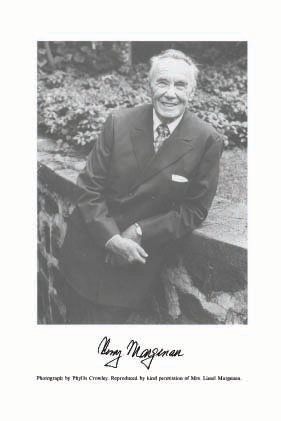
|
|
BIOGRAPHY OF HENRI MARGENAU
|
Henry Margenau (1901 - February 8, 1997) was a German-U.S. physicist and philosopher of science, and Christian writer.
Born Bielefeld, Germany, Margenau obtained his bachelor's degree from Midland Lutheran College, Nebraska before his M.Sc. from the University of Nebraska in 1926, and Ph.D. from Yale University in 1929.
Henry Margenau was a professor in the Department of Physics at Yale University from 1926-1969, and editor of Foundations of Physics, Main Currents of Modern Thought, as well as editor of several journals. His interest in physics grew from a technical expertise in the Zeeman Effect and the measurement of spectral lines, to a broad appreciation of the implications of science for human life and society.
Margenau worked on the theory of microwaves and the development of duplexing systems that enabled a single radar antenna both to transmit and receive signals. He also worked on spectral line broadening, a technique used to analyse and review the dynamics of the atomic bombing of Hiroshima.
Margenau wrote extensively on science, his works including: Ethics and Science, The Nature of Physical Reality, Quantum Mechanics and Integrative Principles of Modern Thought. Margenau served on a commission of the World Council of Churches in developing an ecumenical position on nuclear weapons and atomic warfare.
Margenau was appointed Eugene Higgins Professor of Physics and Natural Philosophy as Yale in 1950, a post he was to hold until his retirement from formal academic life in 1969.
Murray Gell-Mann described the physics course he heard from Henry Margenau. "With a few exceptions most of the physics teaching at Yale wasn't very good. One of those exceptions was Henry Margenau's Physics 32b."
He also became a staff member at both the Institute for Advanced Study, Princeton and the MIT Radiation Laboratory. During his working career, he acted as consultant to the U.S. Air Force, the U.S. National Bureau of Standards, Argonne National Laboratory, Rand Corporation, General Electric Co. and Lockheed. Margenau's work embraced investigation of intermolecular forces, spectroscopy, nuclear physics and electronics. He was also interested in parapsychology. He was married to Liesel Noe and the couple parented two sons and a daughter. Margenau died in Hamden, Connecticut.
Honours and awards:
* Guggenheim Fellowship
* Fulbright Fellowship
* William Clyde DeVane Medal from the Yale chapter of Phi Beta Kappa for outstanding teaching and scholarship (1970).
* Laszlo & Sellon (eds) (1976). Vistas in Physical Reality: Papers in Honor of Henry Margenau.
Works:
H. Margenau published numerous books. A few of them are:
* Margenau, H. (1977). The Nature of Physical Reality: A Philosophy of Modern Physics. Ox Bow Press
* Margenau, H. (1978). Physics and Philosophy: Selected Essays. D. Reidel Co..
* Margenau, H. Truth Journal, Why I am a Christian.
* Margenau, H. (1989). Letter
to M. Nirenberg on science and theology
* Margenau, H. (1965).ESP in the Framework of Modern Science.
* Margenau, H. (1987).The Miracle of Existence, Published by New Science Library, Shambala Books/UK.
A detailed paper devoted to the ideas of Henry Margenau was written by William A. Durbin in ZYGON, v.34 N 1 (1999) p.167.
There are a few places where the biography of HENRI MARGENAU can be found.
Wikipedia electronic Encyclopedia(http://en.wikipedia.org/) , an article HENRI MARGENAU.
Yale University obituary note: HENRI MARGENAU.